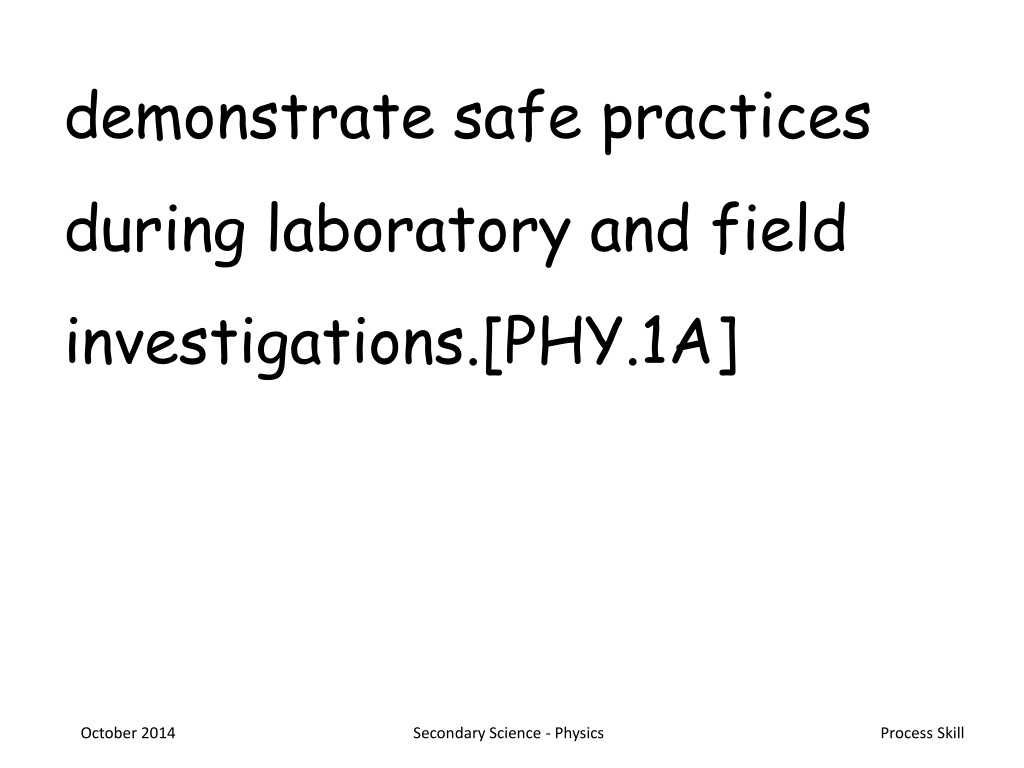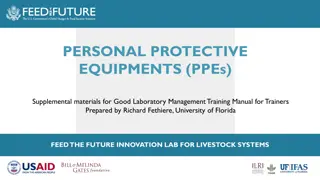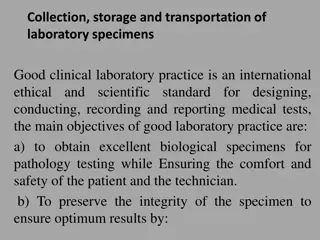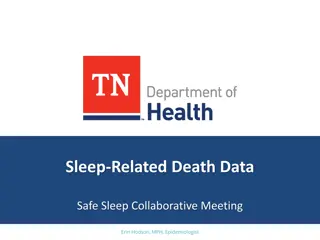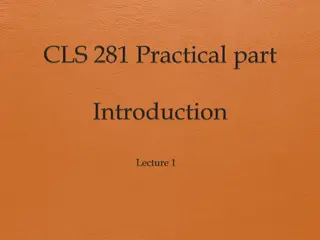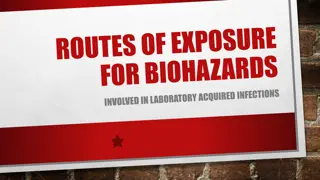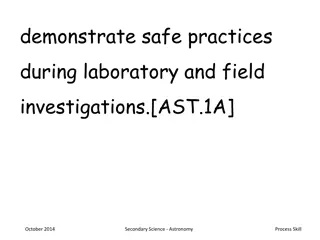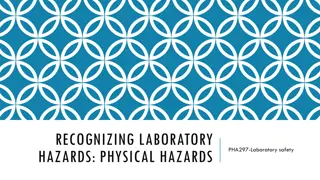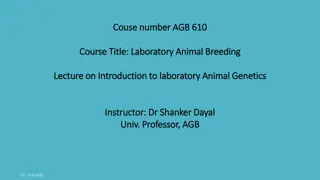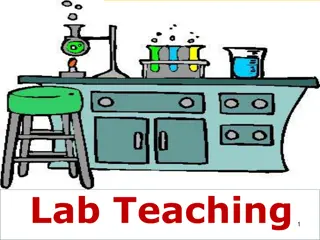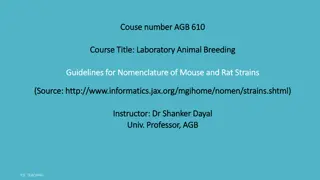Safe Laboratory and Field Practices
In the field of physics, it is crucial to demonstrate safe practices during laboratory and field investigations to ensure the well-being of individuals involved. Understanding the use and conservation of resources, as well as the proper disposal or recycling of materials, is essential for responsible scientific conduct. Additionally, recognizing the limitations of science, understanding scientific hypotheses and theories, and designing investigative procedures are fundamental skills for conducting successful physics experiments.
Download Presentation

Please find below an Image/Link to download the presentation.
The content on the website is provided AS IS for your information and personal use only. It may not be sold, licensed, or shared on other websites without obtaining consent from the author.If you encounter any issues during the download, it is possible that the publisher has removed the file from their server.
You are allowed to download the files provided on this website for personal or commercial use, subject to the condition that they are used lawfully. All files are the property of their respective owners.
The content on the website is provided AS IS for your information and personal use only. It may not be sold, licensed, or shared on other websites without obtaining consent from the author.
E N D
Presentation Transcript
demonstrate safe practices during laboratory and field investigations.[PHY.1A] October 2014 Secondary Science - Physics Process Skill
demonstrate an understanding of the use and conservation of resources and the proper disposal or recycling of materials.[PHY.1B] October 2014 Secondary Science - Physics Process Skill
know the definition of science and understand that it has limitations, as specified in subsection (b)(2) of this section.[PHY.2A] October 2014 Secondary Science - Physics Process Skill
know that scientific hypotheses are tentative and testable statements that must be capable of being supported or not supported by observational evidence. Hypotheses of durable explanatory power which have been tested over a wide variety of conditions are incorporated into theories.[PHY.2B] October 2014 Secondary Science - Physics Process Skill
know that scientific theories are based on natural and physical phenomena and are capable of being tested by multiple independent researchers. Unlike hypotheses, scientific theories are well- established and highly-reliable explanations, but may be subject to change as new areas of science and new technologies are developed.[PHY.2C] October 2014 Secondary Science - Physics Process Skill
distinguish between scientific hypotheses and scientific theories.[PHY.2D] October 2014 Secondary Science - Physics Process Skill
design and implement investigative procedures, including making observations, asking well-defined questions, formulating testable hypotheses, identifying variables, selecting appropriate equipment and technology, and evaluating numerical answers for reasonableness.[PHY.2E] October 2014 Secondary Science - Physics Process Skill
demonstrate the use of course apparatus, equipment, techniques, and procedures, including multimeters (current, voltage, resistance), triple beam balances, batteries, clamps, dynamics demonstration equipment, collision apparatus, data acquisition probes, discharge tubes with power supply (H, He, Ne, Ar), hand-held visual spectroscopes, hot plates, slotted and hooked lab masses, bar magnets, horseshoe magnets, plane mirrors, convex lenses, pendulum support, power supply, ring clamps, ring stands, stopwatches, trajectory apparatus, tuning forks, carbon paper, graph paper, magnetic compasses, polarized film, prisms, protractors, resistors, friction blocks, mini lamps (bulbs) and sockets, electrostatics kits, 90-degree rod clamps, metric rulers, spring scales, knife blade switches, Celsius thermometers, meter sticks, scientific calculators, graphing technology, computers, cathode ray tubes with horseshoe magnets, ballistic carts or equivalent, resonance tubes, spools of nylon thread or string, containers of iron filings, rolls of white craft paper, copper wire, Periodic Table, electromagnetic spectrum charts, slinky springs, wave motion ropes, and laser pointers.[PHY.2F] October 2014 Secondary Science - Physics Process Skill
use a wide variety of additional course apparatus, equipment, techniques, materials, and procedures as appropriate such as ripple tank with wave generator, wave motion rope, micrometer, caliper, radiation monitor, computer, ballistic pendulum, electroscope, inclined plane, optics bench, optics kit, pulley with table clamp, resonance tube, ring stand screen, four inch ring, stroboscope, graduated cylinders, and ticker timer.[PHY.2G] October 2014 Secondary Science - Physics Process Skill
make measurements with accuracy and precision and record data using scientific notation and International System (SI) units.[PHY.2H] October 2014 Secondary Science - Physics Process Skill
identify and quantify causes and effects of uncertainties in measured data.[PHY.2I] October 2014 Secondary Science - Physics Process Skill
organize and evaluate data and make inferences from data, including the use of tables, charts, and graphs.[PHY.2J] October 2014 Secondary Science - Physics Process Skill
communicate valid conclusions supported by the data through various methods such as lab reports, labeled drawings, graphic organizers, journals, summaries, oral reports, and technology-based reports.[PHY.2K] October 2014 Secondary Science - Physics Process Skill
express and manipulate relationships among physical variables quantitatively, including the use of graphs, charts, and equations.[PHY.2L] October 2014 Secondary Science - Physics Process Skill
in all fields of science, analyze, evaluate, and critique scientific explanations by using empirical evidence, logical reasoning, and experimental and observational testing, including examining all sides of scientific evidence of those scientific explanations, so as to encourage critical thinking by the student.[PHY.3A] October 2014 Secondary Science - Physics Process Skill
communicate and apply scientific information extracted from various sources such as current events, news reports, published journal articles, and marketing materials.[PHY.3B] October 2014 Secondary Science - Physics Process Skill
draw inferences based on data related to promotional materials for products and services.[PHY.3C] October 2014 Secondary Science - Physics Process Skill
explain the impacts of the scientific contributions of a variety of historical and contemporary scientists on scientific thought and society.[PHY.3D] October 2014 Secondary Science - Physics Process Skill
research and describe the connections between physics and future careers.[PHY.3E] October 2014 Secondary Science - Physics Process Skill
express and interpret relationships symbolically in accordance with accepted theories to make predictions and solve problems mathematically, including problems requiring proportional reasoning and graphical vector addition.[PHY.3F] October 2014 Secondary Science - Physics Process Skill
